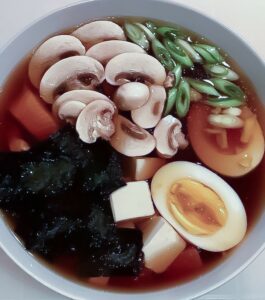
Lately it has been raining a lot in Denmark. The temperature has dropped above minus degrees and instead of snow we get lots of rain. The weather is most reminiscent of autumn weather.
Winter and spring months are perfect for warm, satisfying soups and boost the body with healthy vitamins and minerals.
One of the countries that specialized in filling soups that fit into a busy everyday life is Japan. Most people have heard of the classic ramen soup, which warms right up to the bones and gray everyday life.
Ramen soup is not the only soup that the Japanese enjoy all year round. There are several different types of noodle soups. Soups made with different types of stock, noodles and vegetables.
In Japan, you will not find restaurants that make the same noodle soup. There are many eateries that have developed their own soups from scratch, while others make soups that have been passed down from generation to generation.
On the noodle soup course for beginners, you learn step by step how to make 2 very different Japanese noodle soups from scratch. Soups that taste exactly the same as they are served in restaurants in Japan and not in Denmark.
Read more about Noodle soup course for beginners
_
Zoë has lectured and held sushi courses for A. P. Moller – Maersk, Hugo Boss Nordic, Novo Nordisk, Novartis, Velux, Gorrissen Federspiel, Beierholm revision, Elbek & Vejrup and many more.

